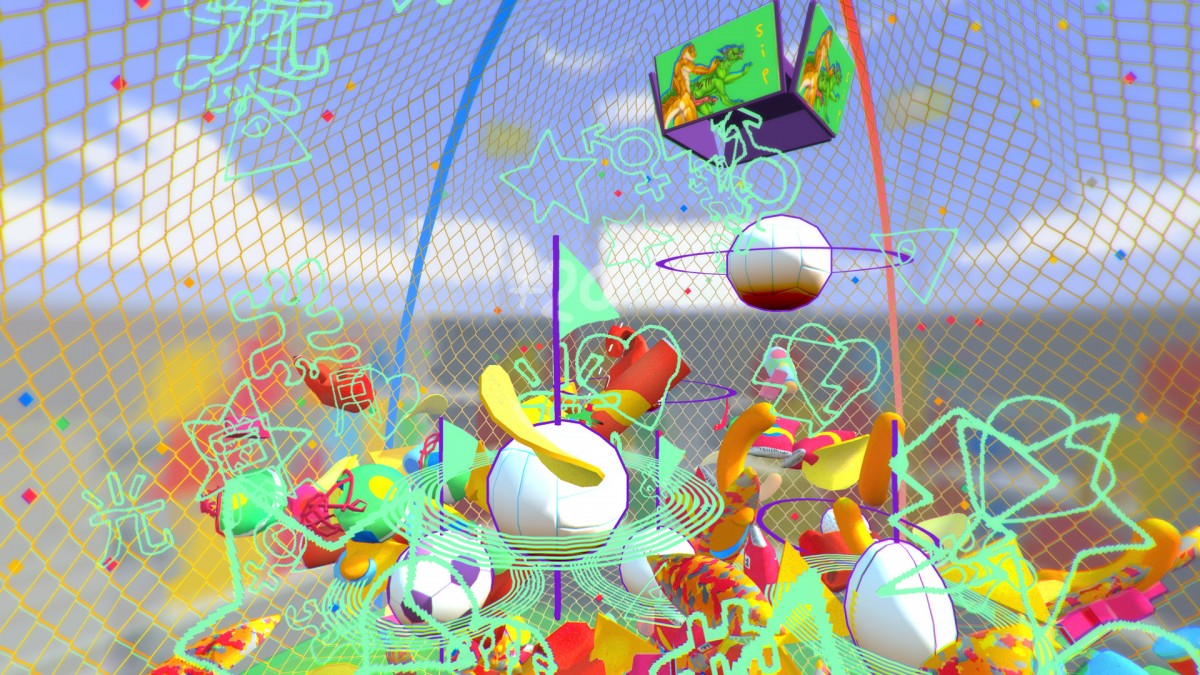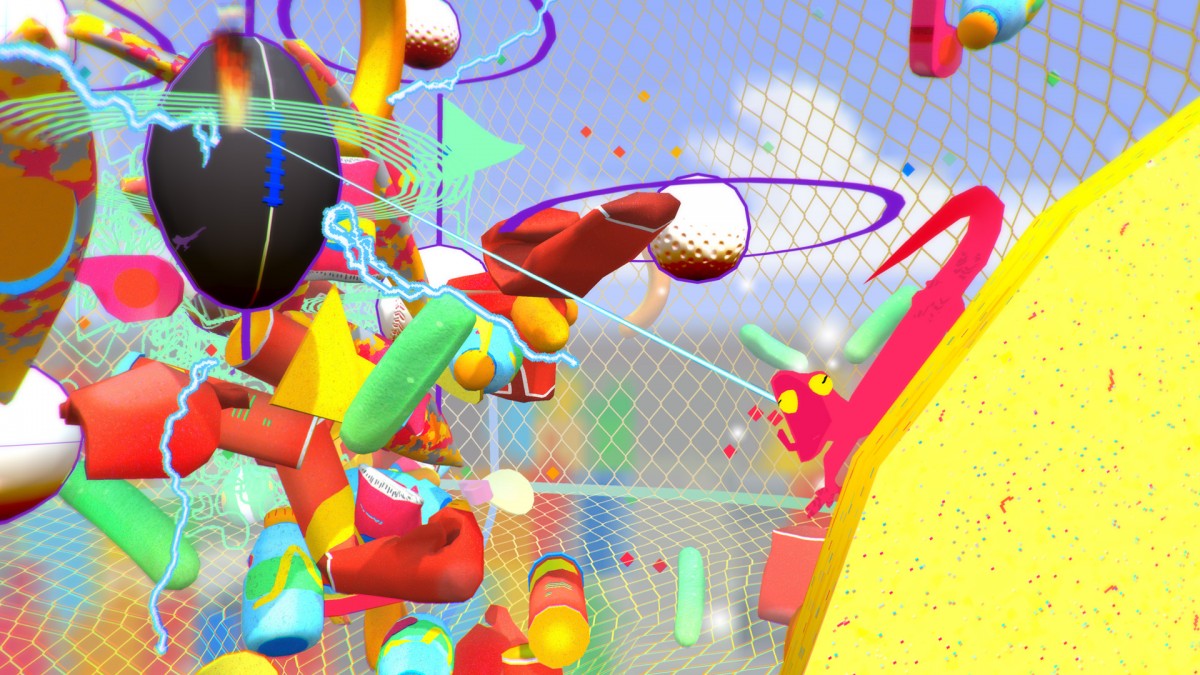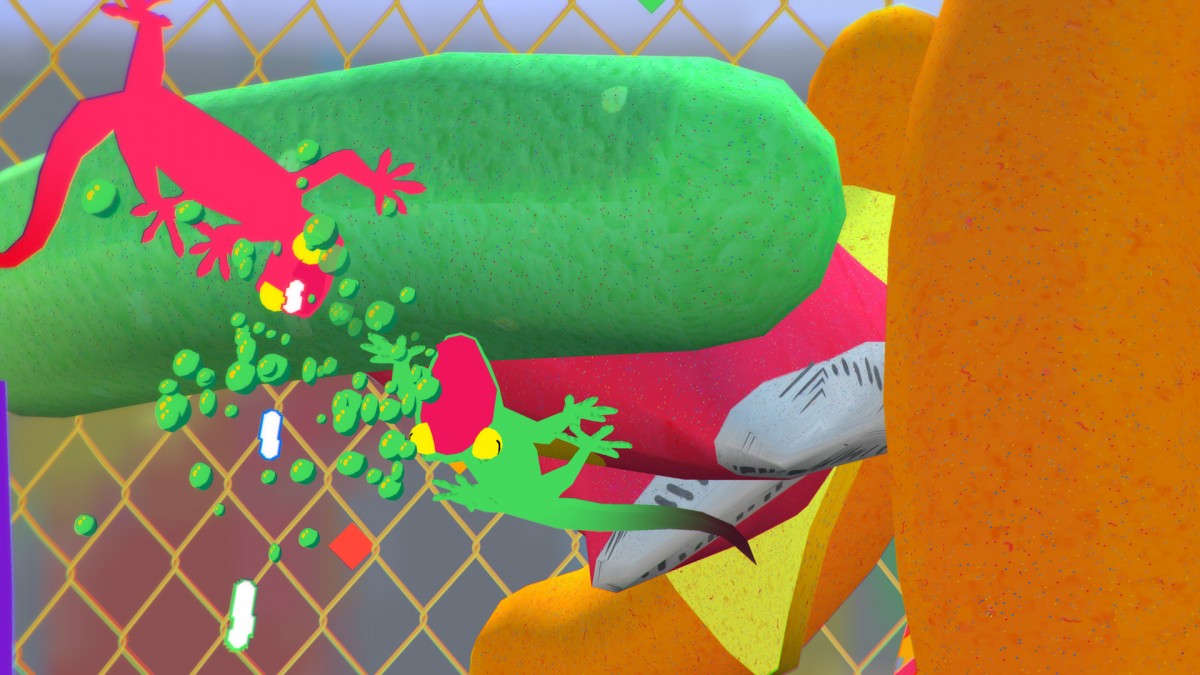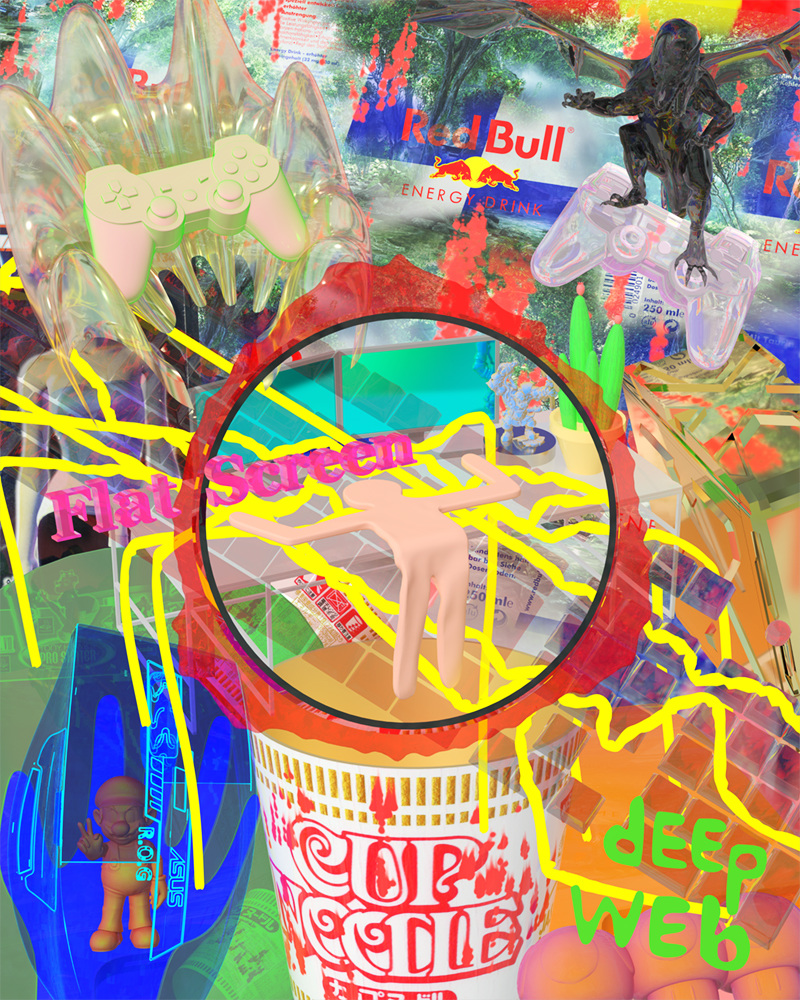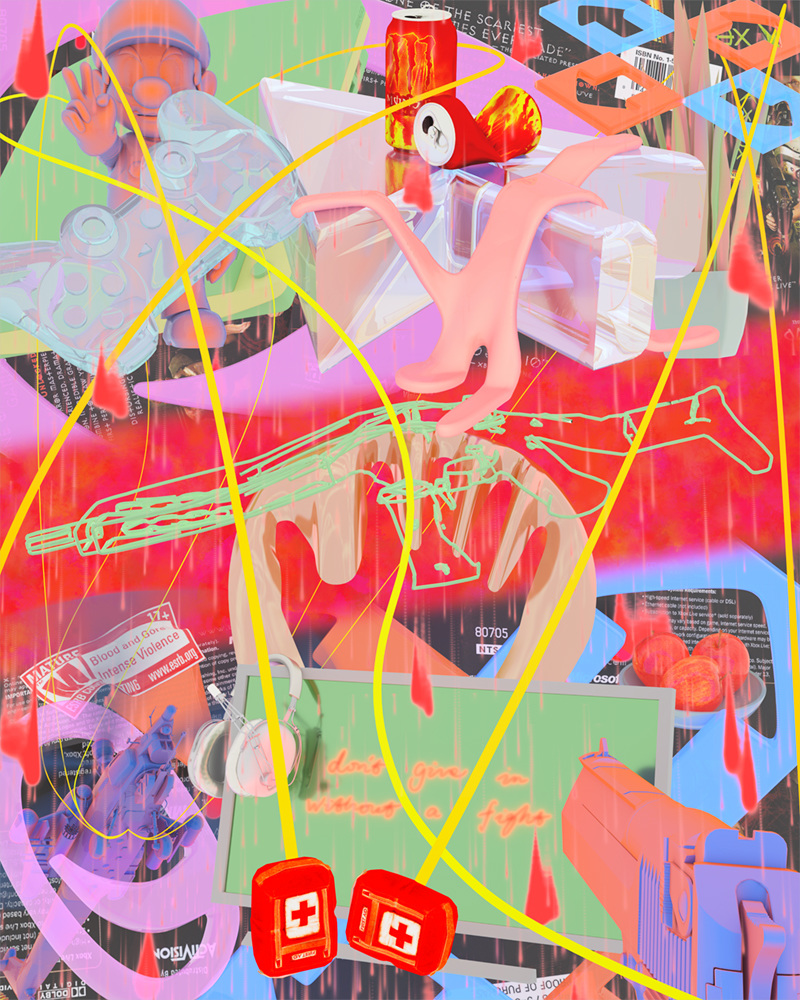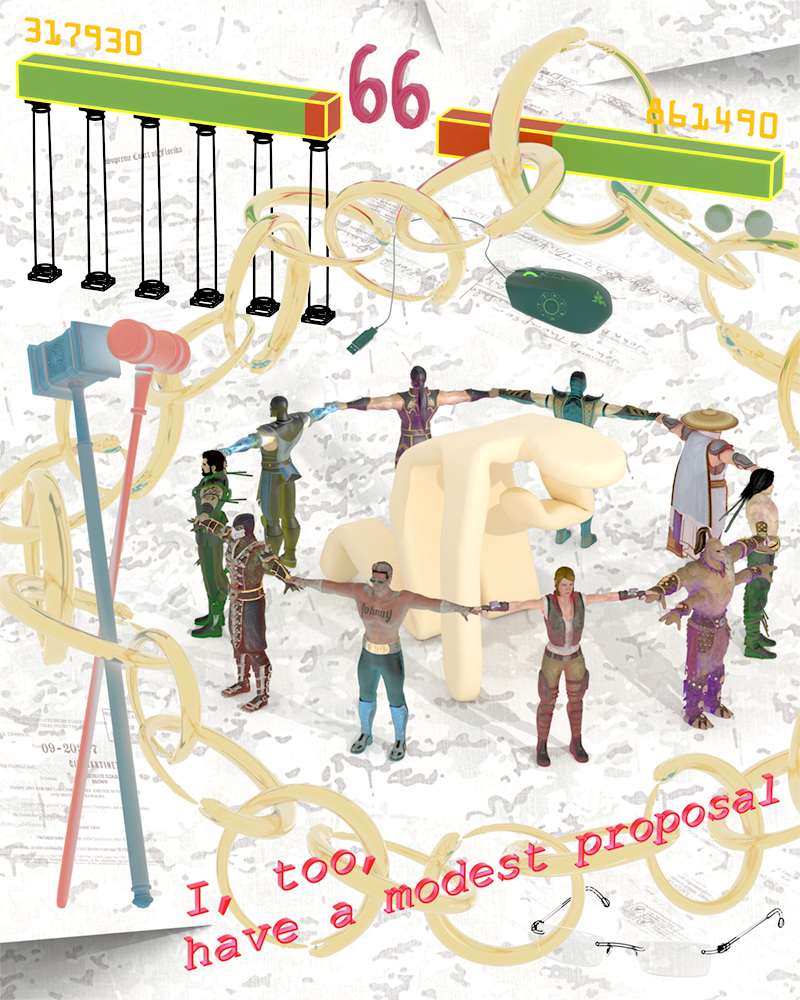Interview with Alex Rickett and Theo Triantafyllidis of Gecko Ridemption
Posted on June 21st, 2017 by David Elliot
This week we interview Design | Media Arts alums Alex Rickett and Theo Triantafyllidis, who recently completed their online multiplayer game Gecko Ridemption now presented online for Adult Swim.
The world of Gecko Ridemption feels rich. It has its own vocabulary: Sport Balls, Puke Force and Layzer Juice. Why did you choose geckos? What is ridemption?
Alex: The game is loosely based on Theo’s previous project Le Petit Architecte which had a similar Katamari Damacy influenced chucking of items, sticking together. That title was controlled with a regular humanoid first person controller, and you could only stand on the structure you built, and couldn’t stick/or hang from it. We were excited about enabling players to engage with their structures more fully, less encumbered by pedestrian humanoid physics. This led us to thinking of geckos, which can stick to virtually any surface. If you could place as a gecko, you could crawl all over crazy, snaky gravity-unfriendly structure.
Theo: I’d like to add that our intention as creators of “gecko ridemption” was to be able to see the world through the beautiful yellow eyes of the gecko. The gecko is a creature of great, near divine importance to us. It is also a well known fact that geckos hate human sports, so we created a sport that they could finally enjoy, thus the ridemption. The visual language we developed for the game was also tailored for the artistic taste of these fascinating reptiles. After extensive experiments we discovered that high RGB values have a pleasing effect on the gecko vertical iris and increases their eye-licking to keep them moist. As a result we picked a brutally saturated color palette and used intense amounts of confetti that would make any gecko autotomize.
So I was surprised how this became something like a sports game, or I guess a capture-the-flag type game. I’m interested in how you determined the form of the game.
Alex: We were also surprised! Le Petit Architecte was a single player game, and did have an implicit goal (trying to reach as high as possible), it was open ended, and this goal, or “rules” of the game are offered gently without any kind of time limit or urgency. That project did an excellent job of negotiating a mix of open-endedness and freedom, while also offering a judicious amount of structure. Our goal was to realize a similar synthesis for Gecko Ridemption as well. We experimented with and considered many systems, and non-systems that would guide players to engage with the most fun, expressive possibilities of the game’s mechanical/visual systems. At the same time, Adult Swim especially emphasized that the game needed to be understood quickly, and be experienced within a brief time duration. The conventional points, rules, and timers are good at facilitating all this.
Theo: We made “gecko ridemption” to push the limits of gecko gameplay, to give geckos the freedom to create beautiful sculptures with sports gear and then be able to slide and slither their sleek adhesive bodies on them. Being able to zap footballs with lazers, apparently the ultimate gecko fantasy, was something a few of them specifically requested.
Gecko Ridemption is a chaotic game, but it has a really good tutorial. Have you made tutorials for other games previously? How did you determine what to put in the tutorial and how it should work?
Alex: I have made them before, but this is by far the most involved tutorial I’ve made. Deciding what to put in wasn’t complicated, because we put everything in. Also, given that it’s a somewhat challenging game to control and the rules are non self-evident, we felt it was important to have a tutorial where you perform all the actions. We also felt that because the matches are competitive, time-limited, and generally stressful, having a safer, more relaxed zone in which to play and build also felt important.
Theo: Tutorials are an art form on their own. We were trying to avoid making one for a while, since we knew that it would become an important part of experiencing “Gecko Ridemption” and thus take up a lot of the development time. We saw this as an opportunity to make a level that is a more relaxing and comfortable free play area, as Alex said. In the main game, distant, shouting spectators and the cage that surrounds the arena are there to condemn gecko captivity, reptile blood sports and the relationship between the sport industry and contemporary politics. Our tutorial is a safe space where geckos can freely shed their virtual skins for a greater cause without any of them really being harmed.
What’s it like to work with Adult Swim? Was there a design spec or other guidelines they gave you? Can you talk about the working relationship a bit?
Alex: They asked to us come up with a pitch based on Theo’s existing project Le Petit Architecte but with the added wrinkle of networked multiplayer. We would give them demo builds and they would give feedback, and request changes. The vast majority of their input was to help reign in the scope, and to reduce friction, and increase clarity in the play experience. Most of their requests were related to controls, camera, UI, tutorial, maintainability. I think this pressure was helpful, and I think our players have a much clearer sense of what’s going on in the game, than if we were left to our own devices. Aside from one gameplay concession (originally, you had to rapidly press a key to take a ball, making capturing more exciting, and unpredictable), but other than this, they gave us a great deal of latitude.
Theo: For me this dialogue was important in creating the game. We enjoyed having complete creative freedom laying out all the important gameplay, aesthetic and structural aspects of the game. The feedback mostly came in the form of revisions that focused on making the game accessible to a broader audience mostly in terms of having clear objectives and a usable interface. The challenging part, given the context of Adult Swim’s “etchetera” page, was that our game had to work both as a 2-minute-attention-span-web-toy and a complex multiplayer game with layers of strategy and replay value.
The game feels like its own artistic world but it’s also a fun competitive game. Have you played other games that work similarly? I’m interested in how you’re responding to those, or ignoring or massively tweaking other games.
Alex: Hmmm… Though I haven’t played it extensively myself, Splatoon for Wii U was a useful reference. It was later in our own development, but I read an interview with those developers, and they went through a very similar process, of starting with the play-mechanics, and gradually building the rules world, and story around that.
Theo: Although very different in its artistic intentions and gameplay, I really enjoyed playing “BroForce”. It has a great combination of humor, irony, engaging gameplay and great game feel. The same team recently developed “genital jousting”, which I am currently looking for players to play with!
Thanks.
Gecko Ridemption is free to play on Adult Swim’s website.

